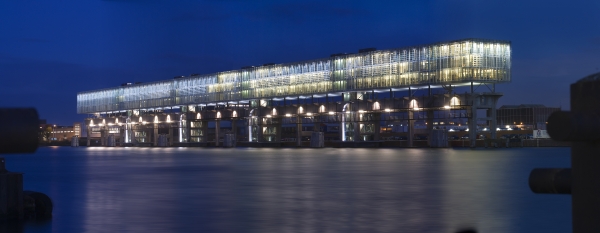Sustainable House-sculpture form an Industrial Ruin
Crane Track, Amsterdam
Architects: Trude Hooykaas, Julian Wolse, Steven Reisinger, Gerald Lindner
Text: Eszter Götz
Photos: Oth Ontwerpgroep

The giant made of concrete was built back in 1952 as a street-size extension, and incoming freighters had been loaded from it with cranes for four decades. The flourishing time of Dutch river navigation is only present today in this region in the form of crumbling ruins, and the city itself regards the whole of the area as the next rust-zone meant to undergo revitalization. A team of architects recognized it as its own would-be centre, and thus the preservation of industrial relics turned out to be the key items concerning the future of the district. The giant office block named Crane Track has came into focus preserving the original concrete shell of the wharf and an entirely transparent longish glass cube was seated onto the brackets to be supported by light steel I-beams to offer a fascinating spectacle day and night. The glass box seems to be floating above the water with its transparent body and slender form counteracting the bulky and clumsy concrete block of the industrial heritage.
Initiative and design: Trude Hooykaas
Architecture: OTH Ontwerpgroep
Architects: Trude Hooykaas, Julian Wolse, Steven Reisinger, Gerald Lindner
Building physics and acoustics consultant: Lichtveld, Buis & Partners BV
Structures: Aronsohn raadgevende ingenieurs
Façade consultant: Façade, Eindhoven
Main contractor: Bouwcombinatie M.J. de Nijs en Zn.



